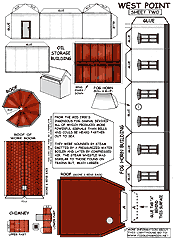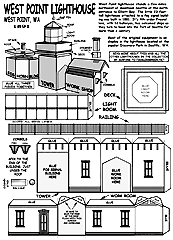

West Point Lighthouse, Seattle, WA
 In November 1981, West Point Lighthouse, at the north entrance to Elliott Bay celebrated its 100th anniversary. The trim, little structure has endeared itself to Seattleites for many years and except for a few additions it is little altered from its inception. Eight years before Washington became a state, the tower was sending out its friendly beams with the same fourth order Fresnel, the illuminent going through the evolution from oil to electricity. A 1,000 watt quartz iodine bulb presently lights the lens and gives a sharp flash through the bullseyes with its white and red alternating characteristic. The apparatus makes one revolution per minute.
In November 1981, West Point Lighthouse, at the north entrance to Elliott Bay celebrated its 100th anniversary. The trim, little structure has endeared itself to Seattleites for many years and except for a few additions it is little altered from its inception. Eight years before Washington became a state, the tower was sending out its friendly beams with the same fourth order Fresnel, the illuminent going through the evolution from oil to electricity. A 1,000 watt quartz iodine bulb presently lights the lens and gives a sharp flash through the bullseyes with its white and red alternating characteristic. The apparatus makes one revolution per minute.The first fog signal, a steam whistle was installed at West Point on February 7, 1887, and at the turn of the century a new fog signal building provided equipment to blast second class Daboll trumpets which served many years till the advent of more modern foghorns.

Rising twenty-three feet above the low, sandy peninsula at the north entrance to Elliot Bay, West Point Lighthouse has welcomed ships to Seattle for more than a hundred years. Situated five miles from the city's thriving business core, the old lighthouse stands at the foot of Magnolia Bluff in Discovery Park.
 The
little lighthouse was built in 1881 at a cost to taxpayers of
$25,000, a rather princely sum in those days. Fitted with a complex
fourth-order Fresnel lens with twelve separate bull's-eyes, it
began operation in November of 1881. According to a Coast Guard
estimate, its flashing light has put in more than 400,000 hours
of service. The beacon can be seen from fifteen miles away.
The
little lighthouse was built in 1881 at a cost to taxpayers of
$25,000, a rather princely sum in those days. Fitted with a complex
fourth-order Fresnel lens with twelve separate bull's-eyes, it
began operation in November of 1881. According to a Coast Guard
estimate, its flashing light has put in more than 400,000 hours
of service. The beacon can be seen from fifteen miles away.
Travel information: A popular attraction of Seattle's Discovery Park, the lighthouse is located about a mile and half from the entrance. A pleasant way to enjoy an exterior view of the lighthouse is with a relaxing stroll along West Point Beach. The park offers weekend tours of the lighthouse. Call (206) 386-4236.

Two spacious residences were provided for the keepers which helped make the station a pleasing place to live and raise a family. There has only been one drawback down through the years. Often times during the winter months logs and debris have been cast up on the station grounds, sometimes against the stout masonry tower. Heavy rocks and riprap have frequently been collocated to protect the lighthouse which is located precariously near the water.
The beacon has been placed in the National Register of Historic Places which assures its preservation. From its seaward side opens one of the more scenic vistas of Puget Sound, both Mount Rainier 4nd Mount Baker standing out in all their glory on a clear day. Marine traffic passes close to shore, affording a continuous parade.
When West Point Lighthouse was automated in 1985, 1t marked the passing of a 130-year era in Washington lighthouse history. The diminutive beacon was the last of its kind in the Evergreen State to be tended by a resident keeper.
The lighthouse, five miles northwest of downtown Seattle, has seen a welcome fixture at the north entrance to Elliott Bay since 1881 - jutting conspicuously into the bay below Magnolia Bluff, the everwatching sentinel commands a front row seat for the perpetual parade of commercial marine traffic in and out of lower Puget Sound ports.
Anticipating the further growth of waterbome traffic in the wake of Seattle's flourishing lumber export business, the Lighthouse Board In 1872 recommended a lighthouse at West Point. Congress responded with a $25,000 appropriation and, in 1881, workers completed construction of a brick/stucco lighthouse and dual keeper's houses at the tip of the sandy spit. The squat square tower supports an octagonal lantern containing a fourth-order Fresnel lens. Although its red and white flashes emanate from only 27 feet above the water, they are sufficiently lofty and powerful to be visible more than 15 miles up and down the sound.
West Point Light is accessible via Discovery Park, a 543-acre natural area that is Seattle's largest city park. The popular site, which encompasses the late Fort Worden, provides meaningful open space for visitors and a sanctuary for wildlife.



